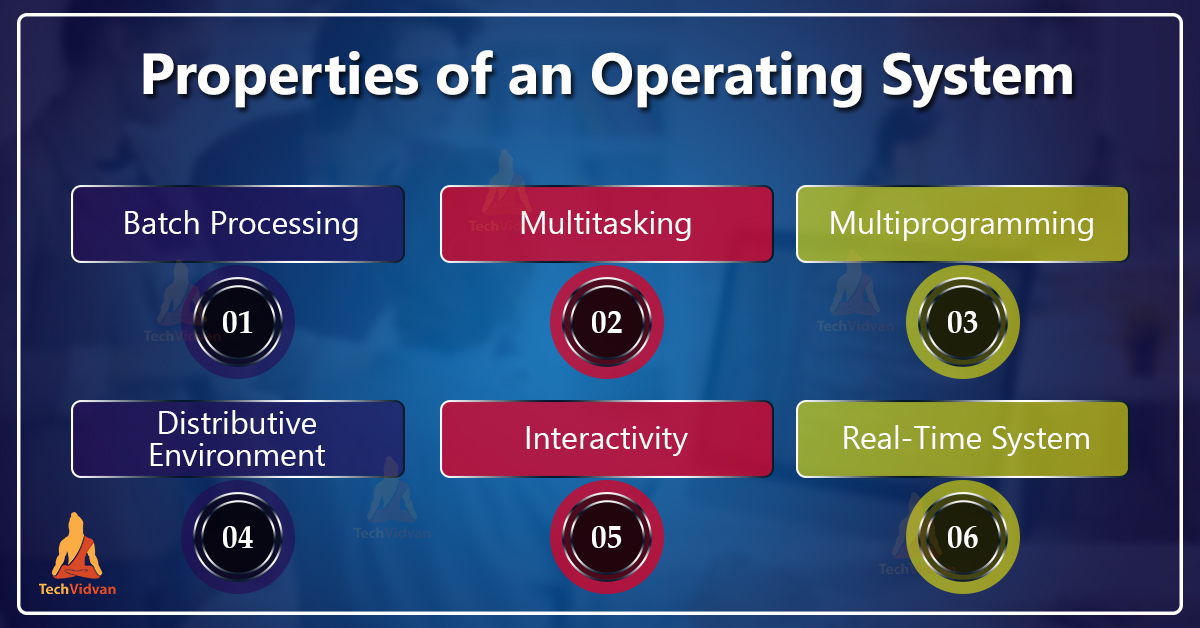An operating system is an interface that makes things easier for the users. The services provided by the OS is something that it offers to both the user and the system to simplify communication between them.
But it has multiple properties too. These properties of an Operating System are more like the tasks undertaken by an OS rather than a characteristic to make the system user-friendly.
Properties of Operating System
Below are the properties of the OS that allow it to perform all its services and functions smoothly.
1. Batch Processing
This is the process of collecting programs and data together in a batch before execution or processing. The OS defines the jobs using a predefined sequence of commands, data, or programs, as a single unit.
The system memory stores these jobs before execution and the processing of these jobs depends on a first come first serve basis.
Once the OS completes the execution of a job, it releases the memory and copies the output into an output spool for later printing. This increases the performance of a system as a new job starts early as soon as the old one gets completely executed without any manual interference.
There is also a rare chance of the jobs entering an infinite loop. This type of processing also makes debugging difficult.
Advantages:
- It reduces the load of the operator.
- It increases performance as the new job starts execution as soon as the previous one finishes without any manual intervention.
Disadvantages:
- Debugging is difficult.
- There is a chance that a job may enter an infinite loop.
- Lack of protection scheme results in one batch job affecting the pending jobs.
2. Multitasking
The CPU can execute multiple tasks simultaneously by switching among them. Such a system is known as the time-sharing system and has a very fast response time. These tasks switch so fast that the users can interact with each running program easily.
Advantages:
- Saves users time.
- Increases the response time of a system.
- Utilizes resources efficiently.
Disadvantages:
- It can negatively affect the speed of a system in the long run.
3. Multiprogramming
This happens when the system memory stores more than one process. The OS executes these processes parallely on the same processor. Multiple processes share the processor i.e., the CPU which increases CPU utilization.
The CPU executes one job at a time while the others are in waiting state, waiting for the processor to be assigned to them.
The OS makes sure that the CPU is never idle by monitoring the state of all the system resources and active programs using memory management programs. This also gives a false sense to the user that the CPU is simultaneously working on multiple programs.
Advantages:
- It provides high and efficient CPU utilization.
- It gives an illusion to the users that multiple programs are allotted CPU almost simultaneously.
Disadvantages:
- CPU scheduling is necessary to perform multiprogramming.
- Memory management accommodates multiple jobs in the memory.
4. Distributive Environment
Multiple independent processors constitute a distributive environment. The OS distributes computation logic among different physical processors and manages communication between them. The processors don’t share the memory or clock, rather they have their own local memory.
Advantages:
- Failure of one processor doesn’t affect the whole system.
- There is no limit to how many processors can be added in the group.
- Debugging is easy.
- It has the computing power of multiple computers.
Disadvantages:
- Troubleshooting is difficult.
- Software support is less.
- Setting up a network for this environment is costly.
- There is a threat to security and data integrity can be endangered.
5. Interactivity
Interactivity is the capability of the user to interact with a system. The OS provides an interface to interact with the system, manages the I/O devices, and ensures a short response time.
Advantages:
- Easy to use
- Helpful for specially-abled people.
Disadvantages:
- Can cause noise pollution.
- Difficult to design.
6. Real-Time System
We consider dedicated embedded systems as real-time systems. In this, the OS reads and reacts through the sensor data and gives a response in a fixed time period to ensure correct performance.
Advantages:
- Fast and timely response
- Good for tasks, bound by tight time constraints.
Disadvantages:
- Frequent program crashing.
- Highly complex
7. Spooling
Simultaneous peripheral operation online, spooling is the process of pushing data of various I/O jobs in a buffer, disk, or somewhere in the memory so that a device can access the data when it is ready.
The OS handles I/O device data spooling as the devices have diverse data access rate in order to maintain the spooling buffer. Buffer is like a waiting station where the data can rest while the slower devices are catching up. The application of spooling is Print Spooling.
Advantages:
- It uses a disk as a buffer.
- It can overlap I/O operation for one job with the help of processor operations for another job.
Disadvantages:
- Requires a large amount of storage.
- Increased disk traffic
Summary
Above are the 7 properties of the Operating System. Batch processing is the execution of programs in a group that increases system performance. Multitasking is executing multiple tasks simultaneously by switching between them.
Multiprogramming is the parallel processing of programs to increase CPU utilization. A distributive environment is a collection of multiple processors that communicate via a network line.
The OS provides an interface that increases interactivity between the user and the system. Real-time systems respond in a given time frame in order to ensure high performance.
Spooling pushes data in a buffer where it can take a break while the I/O devices catch up to it. These properties are the main traits of the operating system that define the OS in a simplified manner, making it a lot less complex.

